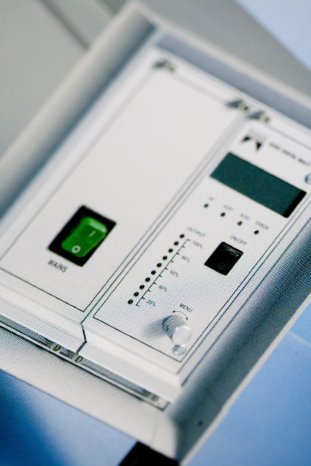The cleaning power of ultrasound is based on cavitation which is created in a tank of liquid. It removes both film-like and particulate contamination, even from assemblies with complex geometry, such as indentations, blind holes, grooves and hollows. This allows complete assemblies to be cleaned without needing to be disassembled. At the same time, ultrasonic cleaning allows the use of chemicals to be reduced and the treatment time to be significantly shortened. Alongside reproducible cleaning results, this makes it the cleaning process of choice for many applications in the automotive and supply industry, the mechanical and plant engineering sector, the fitting/fixtures and sanitary facility industry, the field of optics and precision mechanics, the watch and clock-making industry, the fields of electroplating, electronics, microtechnology and photovoltaics, the semiconductor industry, the field of maintenance and reprocessing and many other sectors.
Efficient process thanks to perfectly matched generators
A key prerequisite in ensuring that ultrasonic cleaning can play to its strengths is a requirements-based cleaning system design. The following principle applies: the lower the frequency, the higher the energy released by the ultrasonic waves. If the frequency is too low, this can damage sensitive objects, while a frequency that is too high leads to a substandard cleaning result.
With innovative ultrasonic components, Weber Ultrasonics, one of the world's leading manufacturers of leading edge ultrasonic solutions, makes it possible to create cleaning systems that are ideally tailored to the application in question. These include the SONIC DIGITAL ultrasonic generators with frequencies from 25 to 250 kHz. Among other things, they provide extremely high consistency of frequency, amplitude and output, as well as comprehensive safety features - characteristics that help ensure fast and reliable cleaning with consistently good results.
The company has recently added the SONIC DIGITAL GREEN eco-friendly generators to its product range for frequencies between 25 and 40 kHz, which are often used in industrial component cleaning. Thanks to a special eco mode, these enable energy savings of up to 20% while maintaining 100% cleaning power.
Where cleaning tasks such as precleaning and fine cleaning require different frequencies, the SONIC DIGITAL MULTI module ultrasonic generators ensure highly economical and space-saving cleaning systems. These units are able to generate up to three frequencies (40, 80 and 120 kHz or 25 and 50 kHz).
For cleaning highly sensitive components and extremely fine structures, as are often found in photovoltaics, the semiconductor industry and micro and nanotechnology, Weber Ultrasonics has developed the 1 MHz and 500 kHz ULTRASONIC MICRO CLEANING (UMC) ultrasonic module generators. With power outputs of 250 and 500 Watt respectively, they are able to optimally adapt to the respective cleaning requirements. Furthermore, the use of the latest high-tech components allows an extremely compact design – up to six 1 MHz modules can be integrated in a single 19" housing.
Transducer systems that set new standards
Weber Ultrasonics also sets standards when it comes to propagating ultrasonic waves into the cleaning tank with its SONOPUSH and SONOPUSH MONO HD rod transducers, the SONOSUB submersible transducers, which are also available as multifrequency transducers, and SONOPLATE plate transducers. Boasting temperature resistance up to 95°C (inactive up to 120°C), the SONOPUSH MONO HD rod transducer is built to withstand the most demanding environments, depending on the ON time. Unlike conventional rod transducers, it also produces 20% more power output at the same beam length and consistent omnidirectional sonic distribution. The housing of the SONOSUB submersible transducer is laser-welded. The benefits of this are twofold. Firstly, it prevents the transducer elements from re-contaminating or soiling the cleaning and rinsing tanks. And secondly, this innovative welding technique means that the ultrasonic transducer housing can be manufactured with outstanding dimensional accuracy and lack of distortion, thereby creating a significantly higher quality, stronger, yet a smooth and clean welded joint. SONOPLATE transducer systems, which are attached to the outside of the container using a welded or press-on mounting frame, are the ideal solution for ultrasonic cleaning systems where space is at a premium. SONOSUB and SONOPLATE transducers are also available in a high-temperature version for applications such as cleaning processes with high-boiling hydrocarbons.
Alongside its complete component portfolio for ultrasonic cleaning, Weber Ultrasonics will also be presenting its innovative solutions for ultrasonic welding and disintegration of biogenic sludge with ultrasound at the MECSPE trade fair in Parma from 21 to 23 March 2013 (Stand L30 in Hall 6).
www.weber-ultrasonics.com
-----
Thanking you in advance for sending a copy of or link to all publications related to this communication.
Contact partner for editorial matters and requests for photos:
SCHULZ. PRESSE. TEXT, Doris Schulz, (Journalist DJV),
Martin-Luther-Strasse 39, 70825 Korntal, Germany, Tel +49 (0)711 854085,
ds@pressetextschulz.de, www.schulzpressetext.de

